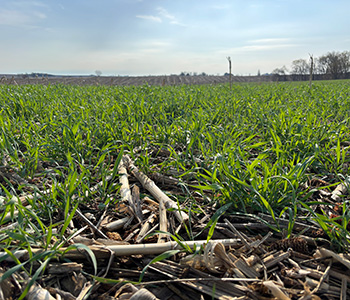Soil Doesn’t Sleep—Why Should Your Fields?
Jun 02, 2025

Landon Van Dyke
Conservation Agronomist
As the growing season quickly moves along, it’s time to think ahead and begin preparing for fall. Fall is the perfect window to set your fields up for a more resilient and productive season ahead—and cover crops are one of the most powerful tools you can use to do just that.
Cover crops aren't just a conservation practice; they're a profit strategy. Whether it’s cereal rye, radishes, crimson clover, or a diverse mix, cover crops help hold your soil in place, scavenge leftover nutrients, and suppress fall and early spring weeds. The result? Improved soil structure, better water infiltration and a head start on next year’s fertility.
Let’s talk bottom line. Fields with cover crops often experience fewer erosion issues, lower input costs over time, and more consistent yields. In dry years, cover crops can help your soil hold on to precious moisture. In wet years, they improve drainage and field access - and with nitrogen costs still running high, having a legume in the mix could mean fewer dollars spent on fertilizer next spring.
The research is in! Across Iowa, hundreds are already using cover crops to buffer against weather events, build soil health and stay competitive in a changing ag economy. But you don’t have to dive in all at once, start with a few fields this fall and see the difference for yourself.
This is your chance to get ahead. Seed is available, support is in place and the benefits are real. Don’t wait until spring to wish you had done something—let this be the year you commit to cover crops!
Take the next step. Pick one field or commit 40 acres this fall to a cover crop. We’re here to help you choose the right mix, source seed and get it in the ground on time.
Let’s build a better farm system—one field at a time.
Conservation Agronomist
As the growing season quickly moves along, it’s time to think ahead and begin preparing for fall. Fall is the perfect window to set your fields up for a more resilient and productive season ahead—and cover crops are one of the most powerful tools you can use to do just that.
Cover crops aren't just a conservation practice; they're a profit strategy. Whether it’s cereal rye, radishes, crimson clover, or a diverse mix, cover crops help hold your soil in place, scavenge leftover nutrients, and suppress fall and early spring weeds. The result? Improved soil structure, better water infiltration and a head start on next year’s fertility.
Let’s talk bottom line. Fields with cover crops often experience fewer erosion issues, lower input costs over time, and more consistent yields. In dry years, cover crops can help your soil hold on to precious moisture. In wet years, they improve drainage and field access - and with nitrogen costs still running high, having a legume in the mix could mean fewer dollars spent on fertilizer next spring.
The research is in! Across Iowa, hundreds are already using cover crops to buffer against weather events, build soil health and stay competitive in a changing ag economy. But you don’t have to dive in all at once, start with a few fields this fall and see the difference for yourself.
This is your chance to get ahead. Seed is available, support is in place and the benefits are real. Don’t wait until spring to wish you had done something—let this be the year you commit to cover crops!
Take the next step. Pick one field or commit 40 acres this fall to a cover crop. We’re here to help you choose the right mix, source seed and get it in the ground on time.
Let’s build a better farm system—one field at a time.